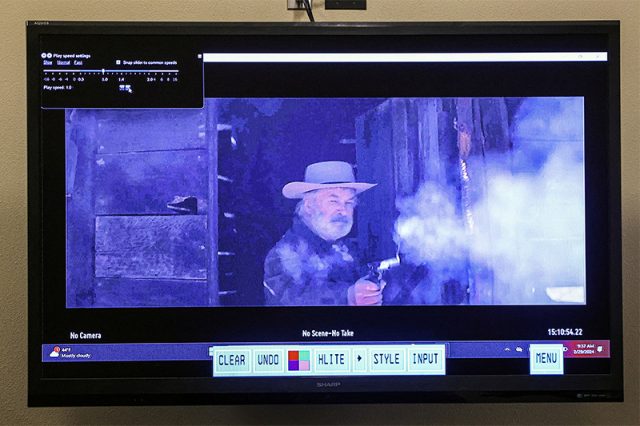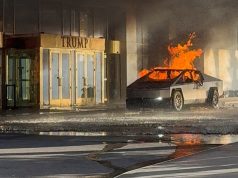
SANTA FE, New Mexico — The inner workings of a Colt .45 “Peacemaker” revolver, a symbol of the American Wild West, have become the focus of Alec Baldwin’s trial for the 2021 fatal shooting of “Rust” cinematographer Halyna Hutchins on a New Mexico movie set.
Jury selection was set to begin on Tuesday nearly three years after Baldwin was directed to point his gun at Hutchins as she set up a camera shot inside a movie-set church about 20 miles southwest of Santa Fe.
Hutchin’s 2021 death was Hollywood’s first on-set shooting fatality in three decades and momentarily sparked calls to end the widespread use of real firearms on movie sets.
Baldwin’s involuntary manslaughter trial in a modern, brown-stucco courthouse in downtown Santa Fe is expected to last eight days and run to July 19.
It is remarkable in that there is little or no precedent in U.S. history for an actor to face criminal prosecution for an on-set shooting death. The “30 Rock” actor could be imprisoned for up to 18 months if found guilty.
In March, “Rust” armorer Hannah Gutierrez, the set employee in charge of firearm safety, was found guilty of involuntary manslaughter by a Santa Fe, New Mexico, jury for mistakenly loading a live round into Baldwin’s gun. Gutierrez received the maximum 18-month sentence.
Legal analysts and firearms specialists had long expected Baldwin’s case to hinge on whether he should have inspected the gun after he was told it was “cold,” an industry term meaning it was empty or contained inert, dummy rounds.
But in a pivotal interview in December 2021, Baldwin told ABC News’ George Stephanopoulos he did not pull the trigger, sending prosecutors and defense lawyers into the world of forensic firearms testing.
Baldwin, 66, said he cocked the reproduction 1873 Single Action Army pistol before it fired a live round that killed the rising-star cinematographer and wounded director Joel Souza.
Santa Fe police set out to test Baldwin’s claims. An FBI examination found the gun worked normally and would not fire at full cock without the trigger pulled. State prosecutors filed charges thereafter, alleging Baldwin was lying about the trigger.
Baldwin’s legal team last year countered with photographic evidence the Italian-made Pietta gun’s full-cock notch had been filed down, making it easier to fire. That allowed a mechanical failure or “accidental discharge” without a trigger pull, they said.
Uphill battle
Whether the revolver was modified or not, legal experts see an uphill battle for the prosecution to prove Baldwin knew he could kill Hutchins but showed willful disregard to the risk – a level of criminal negligence required for an involuntary manslaughter conviction.
“The gun is probably the best defense, because there is no way to definitively say what the condition of the firearm was,” said gun historian Ashley Hlebinsky who is executive director of the University of Wyoming Firearms Research Center.
Prosecutors last year dropped charges, convinced the gun was modified, only to have a grand jury reinstate them in January after independent firearms expert Lucien Haag confirmed findings of the FBI examination.
The FBI destroyed the gun during testing and the actor’s lawyers said they were left with no way to prove it was modified.
“The worst evidence against Baldwin is the FBI ballistics report that says he pulled the trigger, and his ABC interview where he said he didn’t,” said Neama Rahmani, a Los Angeles trial attorney and former federal prosecutor.
Another possible hurdle for the prosecution is persuading jurors Baldwin is guilty of criminal negligence after Gutierrez and first assistant director Dave Halls were convicted for the shooting. Halls accepted blame in a plea deal, acknowledging he did not check rounds in Baldwin’s gun. He was convicted on a misdemeanor charge and given a six-month suspended sentence.
“Juries have difficulty with the idea that people can share guilt,” said University of New Mexico law professor Joshua Kastenburg, a former lawyer and judge in the U.S. Air Force.
Still, jurors may not buy Baldwin’s argument that, as an actor, he was not responsible for firearms safety and relied on set experts like Gutierrez and Halls.
Gun ownership is common in the Southwest United States where there is a cultural norm to check a weapon and never point it at someone and pull the trigger, according to Hlebinsky.
Then there is Baldwin’s on-set behavior.
Using videos and photos from “Rust” filming, state prosecutor Morrissey will try to show Baldwin was a man with “no control of his emotions,” whose “off script” firing of guns, pointing them at people and rushing of Gutierrez to reload weapons contributed to a collapse in firearms safety, according to court filings.
The judge in the case ruled on Monday Baldwin’s producer role could not be linked to Hutchins’ death, marking a possible setback to prosecutors who argued the actor was the de facto “boss” of the set and responsible for overall firearm safety.
The two other most powerful people on the set, Souza and Halls, are likely to defend the actor. Both have been called as witnesses by the defense and prosecution, respectively.
During Gutierrez’s trial, Souza and Halls dismissed Baldwin’s on-set antics as typical of high-powered actors.
Baldwin’s best defense may be doubts his lawyers can sow about the workings of the pistol, according to Hlebinsky.
“I don’t think anyone can say 100% what happened,” said the firearms historian, who has acted as an expert in court cases on single action Colt. 45 type revolvers similar to Baldwin’s.
—Reporting By Andrew Hay; Editing by Donna Bryson, Aurora Ellis and Chizu Nomiyama








